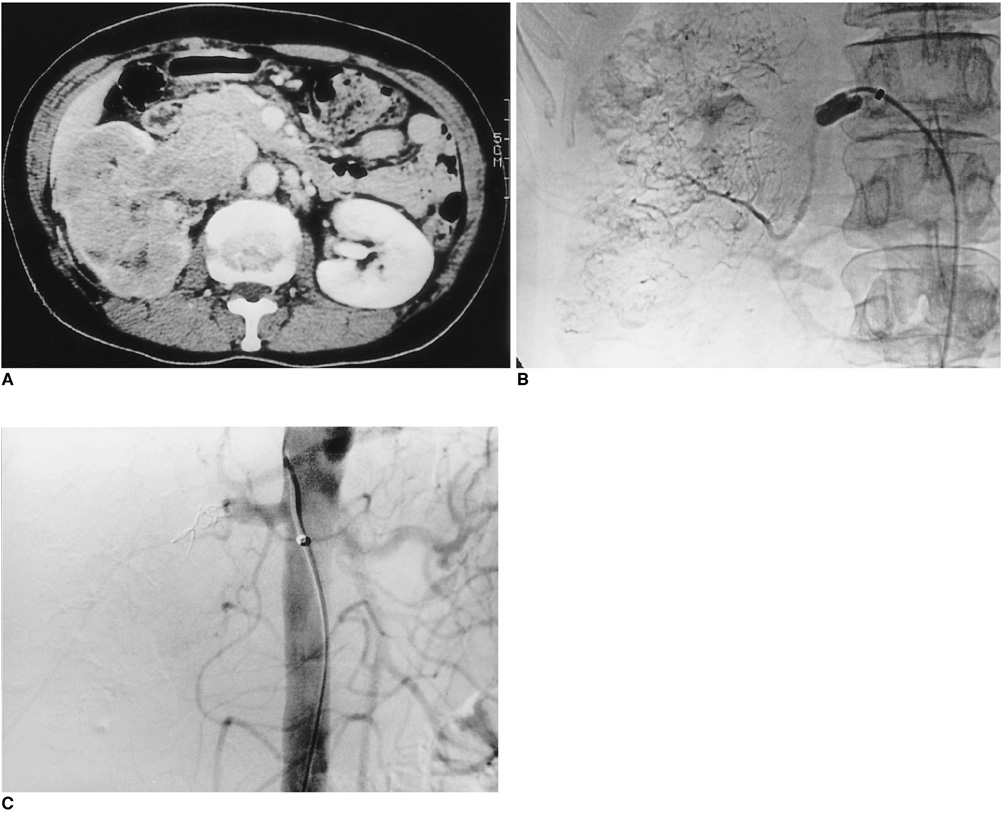Korean J Radiol.
2000 Sep;1(3):121-126. 10.3348/kjr.2000.1.3.121.
Renal Artery Embolization Using a New Liquid Embolic Material Obtained by Partial Hydrolysis of Polyvinyl Acetate (Embol):Initial Experience in Six Patients
- Affiliations
-
- 1Department of Diagnostic Radiology, Yonsei University College of Medicine, Seoul, Korea.
- KMID: 877071
- DOI: http://doi.org/10.3348/kjr.2000.1.3.121
Abstract
OBJECTIVE
To evaluate the therapeutic efficacy of a new liquid embolic materi-al,Embol, in embolization of the renal artery. MATERIALS AND METHODS: Embol is a new embolic material obtained by partial hydrolysis of polyvinyl acetate mixed in absolute ethanol and Iopromide 370 and manufactured by Schering Korea, Kyonggido, Korea. Six patients who underwent embolization of the renal artery using Embol were evaluated. Four were male and two were female and their ages ranged from 11 to 70 (mean, 53) years. Clinical and radiologic diagnoses referred for renal artery embolization were renal cell carcinoma (n = 3), renal angiomyolipoma (n = 2) and pseudoaneurysm of the renal artery (n = 1). After selective renal angiography, Embol was injected through various catheters, either with or without a balloon occlusion catheter. Changes in symptoms and blood chemistry which may have been related to renal artery embolization with Embol were analyzed. RESULTS: The six patients showed immediate total occlusion of their renal vas-cular lesions. One of the three in whom renal cell carcinoma was embolized with Embol underwent radical nephrectomy, and the specimen thus obtained revealed 40% tumor necrosis. In the two patients with angiomyolipomas, the tumors decreased in size and abdominal pain subsided. Bleeding from pseudoaneurysm of the renal artery was successfully controlled. Four patients showed symptoms of post-embolization syndrome, and one of these also showed increased levels of blood urea nitrogen and creatinine. One patient experienced transient hyperten-sion. CONCLUSION: Embol is easy to use, its radiopacity is adequate and it is a safe and effective embolic material which provides immediate and total occlusion of renal vascular lesions.
Keyword
MeSH Terms
Figure
Reference
-
1. Edling NP, Ovenfors CO. Interventional embolization in selective renal arteriography: an experimental study in dogs. Acta Radiol Diagn. 1964. 2:316–320.2. Kalman D, Varenhorst E. The role of arterial embolization in renal cell carcinoma. Scand J Urol Nephrol. 1999. 33:162–170.3. Sung KB, Park SS, Yoon HK, et al. Study on effectiveness and safety of portal vein embolization using a new liquid embolic material (Embol-78-12) in pigs. J Korean Radiol Soc. 1999. 40:237–246.4. Park SS, Yoon HK, Lee NS, et al. Portal vein embolization with use of a new liquid embolic material: An experimental study. J Vasc Interv Radiol. 1999. 10:339–345.5. Segni RD, Young AT, Qian Z, Castaneda-Zuniga WR. Castaneda-Zuniga WR, Tadavarthy SM, Qian Z, Ferral H, Maynar M, editors. Embolotherapy: agents, equipment, and techniques. Interventional radiology. 1997. Baltimore: Williams and Wilkins;29–103.6. Lanigan D, Jurriaans E, Hammonds JC, Wells IP, Choa RG. The current status of embolization in renal cell carcinoma-A survey of local and national practice. Clin Radiol. 1992. 46:176–178.7. Park JH, Kim SH, Han JK, Chung JW, Han MC. Transcatheter arterial embolization of unresectable renal cell carcinoma with a mixture of ethanol and iodized oil. Cardiovasc Intervent Radiol. 1994. 17:323–327.8. Dickinson M, Ruckle H, Beaghler M, Hadley HR. Renal Angiomyolipoma: Optimal treatment based on size and symptoms. Clin Nephrol. 1998. 49:281–286.9. Lee W, Kim TS, Chung JW, Han JK, Kim SH, Park JH. Renal angiomyolipoma: Embolotherapy with a mixture of alcohol and iodized oil. J Vasc Interv Radiol. 1998. 9:255–261.10. Perini S, Gordon RL, LaBerge JM, et al. Transcatheter embolization of biopsy-related vascular injury in the transplanted kidney: Immediate and long-term outcome. J Vasc Interv Radiol. 1998. 9:1011–1019.11. Phadke RV, Sawlani V, Rastogi H, et al. Iatrogenic renal vascular injuries and their radiological management. Clin Radiol. 1997. 52:119–123.12. Beaujeux R, Saussine C, Al-Fakir A, et al. Superselective endovascular treatment of renal vascular lesions. J Urol. 1995. 153:14–17.13. Sadato A, Taki W, Ikada Y, et al. Experimental study and clinical use of polyvinyl acetate emulsion as liquid embolisation material. Neuroradiology. 1994. 36:634–641.14. Hamada J, Ushio Y, Kazekawa K, Tsukahara T, Hashimoto N, Iwata H. Embolization with cellulose porous beads, I: An experimental study. Am J Neuroradiol. 1996. 17:1895–1899.15. Miller DL, Bacher JD, O'Leary TJ, Maxwell M. Comparison of hot contrast material and hot saline for renal ablation in a canine model. Invest Radiol. 1986. 21:56–63.16. Irie T, Kusano S. Fragmented platinum microcoils as embolization material. Acta Radiol. 1996. 37:696–699.17. Lammer J, Justich E, Schreyer H, Pettek R. Complications of renal tumor embolization. Cardiovasc Intervent Radiol. 1985. 8:31–35.
- Full Text Links
- Actions
-
Cited
- CITED
-
- Close
- Share
- Similar articles
-
- Portal Vein Embolization with a New Embolic Material: Preliminary Study in Pigs
- A New Liquid Embolic Agent(Embol) for Transcatheter Renal Artery Embolization: An Experimental Study in Rabbit
- Study on Effectiveness and Safety of Portal Vein Embolization using a New Liquid Embolic Material(Embol-78-12)in Pigs
- Preoperative embolization of meningiomas
- Changes of the Renal Arteries Accordding to Various Embolic Materials




